Serenity pervades Delft Island
By Naalir Jamaldeen
The Delft Island known as Neduntheevu or Neduntivu is famous for its
natural beauty and can be developed into a tourism destination on the
same lines as Hikkaduwa. The island is in the Palk Strait of Northern
Sri Lanka.
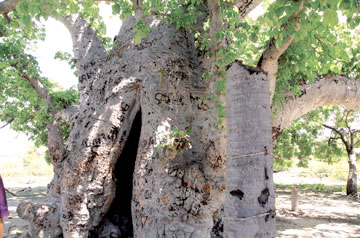 |
| A Baobab tree |
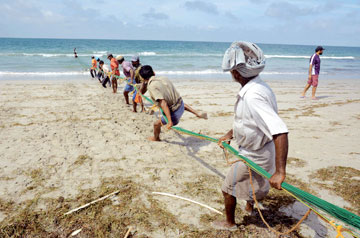 |
| Fisheries
activities in Delft |
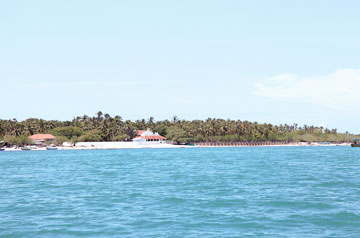 |
| A view of
Delft Island. |
It occupies an area of 50 km and the length of its rough oval-shaped
is 8km and width is about six km. Neduntivu is surrounded by shallow
waters and beaches of coral chunks and sand. There are wild ponies in
the island which were abandoned after the Dutch period. The people in
the island engage in paddy, vegetable and other crop cultivation.
Palmyra palms, dry shrubs and grass grow on the pale, grey spongy coral
lined soil.
Papaw and banana are cultivated in the residential areas. Ruins of a
1000 year- old temple built by the Chola dynasty and the ruins of a
Dutch colonial port still remain. Facilities to promote the tourism
industry in the Delft Island are abundant. The water in the Island is
slightly salty. People fetch water from shallow wells using buckets made
from Palmyra palm leaves, Development Officer of Delft Divisional
Secretariat Velayutham Sivakaran said in an interview with the Sunday
Observer.
Delft Island portrays the unique features of Sri Lanka. After
reaching to Kurikadduwan, a ferry can be taken to Delft Island. A group
of ponies can be seen roaming in the island.
There are some fish varieties identical to Delft. Palmyra trees, dry
shrubs and semi arid tropical type plants can be seen. In the West of
the island ruined complex of south Indian Chola architecture can be
seen.
A ruined dagoba, is positioned beside the ruins. A pigeon house made
by the Portuguese, still exists in the island, Sivakaran said.
The Portuguese used pigeons to communicate. Significantly, the people
who visit can see a Giant Baobab tree planted in the island.
Simultaneously 15 people can hide under a trunk of the tree. All the
walls secure the site are made of blue corals. Baobab trees are grown in
African countries, Portuguese brought some Baobab saplings to Sri Lanka
and nowe can be found in Mannar, the Development officer said.
The sandy beach in the Delft island are unique.Tourists will enjoy
these beaches. It is the ideal location for enthusiastic explorers. The
RDA operates a boat service between Jaffna and Delft. The boat operators
refrain from operating when the sea is rough. The 'Meeting of seven
seas' is an idyllic spot, where whirlpools are found. Sometimes whales
can also be seen. Land masters are the main mode of transport.
The Dutch Fort made of dead coral chunks is also in the Delft Island.
The remaining fort is still gorgeous.
The Delft Hospital has been set up at the Dutch fort. The majority of
the population in the Delft Island are Catholics. Most of them are
fishermen.
"Devil's well" is another impressive feature in the Delft. The well
provides safe water for the entire island. It is hard to find pure water
in an island located in the sea, according to the Development Officer.
He said referring to people that the well begins from a devil's mouth
and the bottom cannot be seen. The foot print called the 'Giants
footprint' is situated within a few kilometers from the 'Devil's well'.
The ruined Dutch stable and the bird's nest are eye catching, he said.
He said that unique coral formations and Baobab trees are some of the
striking scenes on this unspoilt island
The Portuguese called it Ilha das Vacas, the Dutch called it Delft.
Locally it is known as Neduntivu. Situated in the Palk Straits,
North-West of Jaffna. Delft Island is famous for its wild ponies.
It is a 40 km journey from Jaffna to the Kurikadduwan jetty where the
ferry will take passengers to the island.
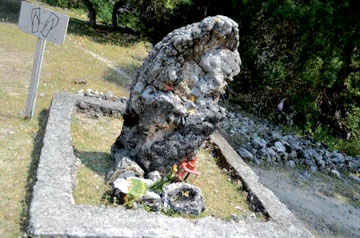 |
| Growing rock |
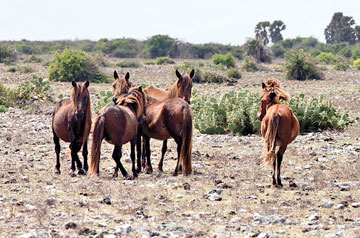 |
| Some wild
ponies |
 |
| Some residents
in the Delft Island |
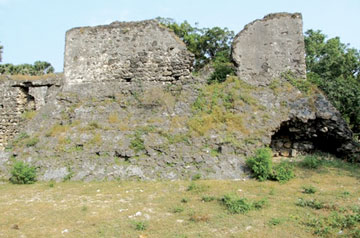 |
| The Delft
Island |
 |
| Pahir fence
surrounding a house |
The ferry journey takes an to reach Delft. Huge coral rocks edge the
shores ofs the visitor, but there is a wild beauty about the place that
is haunting.
Many of the residents of Delft left the island due to the war on
terrorism and it is a small population that still remains, the
Development Officer said.
There are about nine churches in the island. Hindu religion is also
practiced. There are several fishing hamlets and the communities make
dried fish. There is also a post office in Delft. The Indian shore is
visible from certain points in Delft, he said.
Bicycles are also used for transport in addition to land masters.
Bicycles can be considered as main transport mode in the island, he
said. The waters surrounding the island are gem blue and one can wade up
to about 300 metres into the sea. There are also fascinating coral
formations around the island.
The residents have made their protective walls out of chunks of these
rocks. The expanses of Aloe vera grow wild in the white sands in the
island. As plentiful as the corals are the shells to be found, he said.
The water is brackish and good water wells are very difficult to
find. In some areas residents have built tanks and pay for water to be
brought by a bowser. They supply water for money. But there is also the
"Devil's well" - so deep that one cannot imagine that humans dug it, a
fresh water well that apparently does not dry-up even in times of
drought, he said.
Many impoverished people in the the island rear goats, cattle and run
faulty farms. The people in the island live below the poverty line. But
the people are friendly and helpful, he said.
The people in the island are capable of making oil cakes similar to
kavum out of the sap of the Palmyra. Palmyra toddy of Delft is known to
be the best. Many sweets and spicy and savoury fries are made and
packeted for sale, he said.
Wild ponies are a legacy left behind by the Portuguese rulers. Ponies
are not endemic to our country. After the Portuguese left, the Dutch
took them over and then the British used them for transport. Delft
island was used for breeding horses by the Dutch and the British
continued the practice", Sivakaran said.
The Baobab trees are another legacy of the Portuguese who were
supposed to have brought it here for medicinal purposes for the ponies.
There are several Baobab trees in the island. One in particular is
unique as the trunk has a hollow large enough to walk into. Two men can
stand abreast at the entrance. Baobab (Adansonia) is native to
Madagascar, Australia and Africa, he said.
Another site of interest is the ruins of a castle built by the
Portuguese. Also a pigeon house with a stone cote for carrier pigeons,
the only means of communication in Portuguese times. The Dovecote is
about eight feet in height is made of coral stone. There also are ruins
of a Dutch fort, made of dead coral rock.
Another recent happening is a "growing stone". Measurements taken
periodically show a change over the years.
The islanders revere it and now have made it a shrine. There is also
the "Giant's footprint" engraved on a stone and supposedly a similar
footprint exists in the nearby island of Nainativu, he said.
Monkeys, shore birds and land birds, the harmless sand boa python and
other snakes can also be found here. Unspoilt and untouched by
modernity, Delft island offers a wild experience, he said.
There were 13 schools in the Delft and now only nine function.
Classes are held till G.C.E (A/L) in three schools, till grade nine in
one and till grade five G.C.E (A/L) classes are held only in the Arts
stream. Students who attended Jaffna schools have been selected to many
faculties in the Universiy. We have requested the relevant authorities
to take steps to solve this problem.
Two doctors serve in the Delft hospital on a shift basis, one per
week. There is no medicine for snake bites and maternity case as well.
They have to be taken to the Jaffna hospitals. Because Delft is an
island when the sea is rough, ambulance boats don't operate. It takes 40
minutes for an ambulance boat to get to the next bank. The time taken
should be reduced by 20 minutes then the people in the island will
benefit, he said.
Transport is the main problem for people in the island. Passenger
transport service is only available. Products can't be taken to Jaffna.
Due to this cause the people in the island undergo immense difficulties.
There are no quality boats for passenger transportation. Harbour
facility is also not available in the island. There is no ferry boat
service to carry vehicles and other products. Electricity has not been
supplied to all parts. But President Mahinda Rajapaksa has taken steps
to provide electricity to everyone, he said.
The Delft Divisional Secretariat Building has been constructed at a
cost of Rs. 78 million. Facilities in other Divisional Secretariat
Offices in the Jaffna district will be available in The Delft DS Office.
Now Internet and telecommunication facilities have been developed in the
Delft Island. There is a human resource issue in the DS office. Risk
allowance is not given to those employed here. Quarters have been
constructed for Government employees and teachers. Because of sea
transport nobody is willing to serve in the Delft, Sivakaran said.
Drinking water is a problem that has to be addressed immediately and
turns into a major problem from May to October. Sea transport from May
to October is a journey between life and death because heavy winds and
rain overtake the island.
There are no strong boats to be used during this period. An
unseaworthy boat `is in service between Jaffna and the Delft.
If sea transport is favourable Delft island can be developed on par
with other areas in the country. During the South West and North-East
monsoon, the sea is rough.
"Livestock, cultivation and fishery are the livelihoods of the
people. They earn an income even from Palmyra. Nearly 600 families are
engaged in fisheries. The Pahir fence system is used to protect
cultivation from animals. The Pahir system sustains for nearly 400
years. In certain places paddy is cultivated during the rainy season.
Onion, ladies fingers, Orid dhal and green gram are also cultivated. In
certain places up country vegetables such as carrot, beetroot are also
cultivated. There are six large tanks and over 200 small tanks in Delft
Island.
"When transport and other problems are solved the tourism industry
will boom in the Delft Island", he said. |

